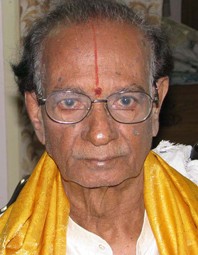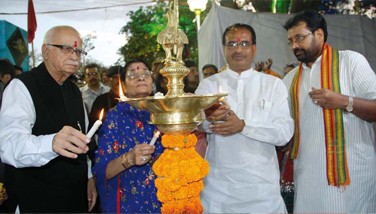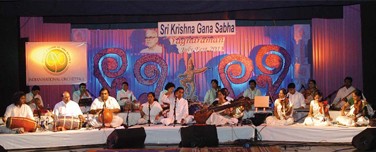MAIN FEATURE - “I am what I am because of my father and my guru”

Mridanga maestro MADRAS A. KANNAN in conversation with LALITHA RAM
Madras A. Kannan was a familiar name to aficionados of Carnatic music concerts in the 1950s and 1960s, especially listeners of All India Radio, where he was a staff artiste of repute. A contemporary of Palghat Mani Iyer and Palani Subramania Pillai, he accompanied all the leading vocalists of the period on the mridanga – Ariyakudi, Semmangudi, GNB, Maharajapuram, T.R. Mahalingam and above all Dandapani Desigar, in whose concerts Kannan was a more or less permanent fixture.
Sruti correspondent Lalitha Ram met Madras Kannan in January 2010 in his V.M. Street, Mylapore, apartment, after much effort to trace the phone number of the reclusive nonagenarian mridanga vidwan and much searching for his house. Shy of the limelight, Kannan was reluctant to meet Lalitha Ram, and yielded the interview only after constant pestering.
Lalitha Ram writes:
Kannan greeted me at the door. Neatly clad in a silk kurta and a spotless white dhoti, Kannan looked all set to leave for a concert. My doubts were reinforced when I saw the grand angavastram on his shoulders and several chains, including a
navaratna haaram with a tiger claw pendant, adorning his chest.
THEATRE - A landmark initiative in Bhopal by GOWRI RAMNARAYAN

The local press did not miss the contrast between the milling crowds L.K. Advani encountered as chief guest at the inauguration of the Madhya Pradesh Natya Vidyalay (Drama School) in Bhopal, and the lukewarm response to the BJP leader at public meetings in the same city.
How heartening that a state government has invested Rs 2 crore in a regional drama school (with a monthly stipend of Rs. 5000 for 25 students)? It may not be enough, but it is a start, with experienced Sanjay Upadhyay, trained at the National School of Drama (NSD), to head it. Before the official launch ceremony, the selected students were introduced, performing Nandipaath composed by Upadhyay, who also led the singing, recalling the auspicious incantations with which the legendary Bharata launched theatre training for the gods.
Ravindra Bhavan was crammed with theatre students, theatre workers, and theatre legends. The overlong inaugural speeches could not dim the enthusiasm of the crowd, not even the stargazers who thronged the hall for Anupam Kher’s monodrama Kuch Bhi Ho Sakta Hai (“Anything Can Happen”), until, reacting to the first stirrings of impatience, Advani brought the house down by musing nonchalantly, “I wonder what Mr. Anupam Kher, waiting in the wings, is thinking of these leisurely proceedings?”
SPOTLIGHT - Sparkling debut by Jayanthi Kumaresh and team by RAMESH VINAYAKAM

Handsome spontaneous applause filled the Krishna Gana Sabha auditorium on 25th June 2011 at the inaugural concert of the Indian National Orchestra premiered at the Yagnaraman July Fest. The audience was expressing its appreciation after an impressive performance by the Indian National Orchestra (INO) that could easily grow into a great orchestra of the morrow.
The July Fest has been forthcoming in encouraging experiments and providing scope to artists in their quest for the new and the beautiful. It was therefore apt that INO was launched on this stage. The ensemble comprising a unique combination of musicians from north and south performed with such self confidence that you wondered whether it was really its first concert.
The Indian National Orchestra was forthright in its statement, an attempt to showcase the majesty of India’s musical culture and tradition. There was pride in the presentation, but, more important, no prejudice.
SEMINAR - Striking a note of optimism
Convener
Arvind Parikh, sitarist, President, Indian Musicological Society; Chairman, ITC-SRA (West)
Moderator
Shanta Gokhale, arts and literary critic, playwright, author
Panelists
Dileep Padgaonkar, Consulting Editor, The Times of India
N. Murali, Senior Managing Director, The Hindu
Naresh Fernandes, Editor-in-Chief, Time Out
V. Ramnarayan, Editor-in-Chief, Sruti
Ayaz Memon, formerly Senior Editor, DNA
Dileep Padgaonkar: I get the uncomfortable feeling that the entire discussion is pitching two different categories – one of preserving, safeguarding and promoting core values of journalism and another of crass commercialism taking over. I don’t believe this kind of dialectic is quite appropriate because in a given society, journalism has to be seen again and again in a social climate and an ideological climate. The New York Times and The Guardian in England devote a lot of space to the arts, obviously because of the kind of the sustained interest in those societies in the arts. This is absent here. The largest
amount of space is devoted to classical music in the newspapers of Japan and South Korea – not to Japanese or Korean music, but Western classical music. The largest number of CDs, music sheets, or anything to do with Western classical music have the biggest market in these two countries. And obviously, that is reflected in the newspapers.


